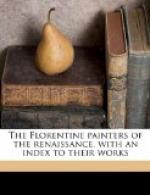In sculpture Donatello had already given body to the new ideals when Masaccio began his brief career, and in the education, the awakening, of the younger artist the example of the elder must have been of incalculable force. But a type gains vastly in significance by being presented in some action along with other individuals of the same type; and here Donatello was apt, rather than to draw his meed of profit, to incur loss by descending to the obvious—witness his bas-reliefs at Siena, Florence, and Padua. Masaccio was untouched by this taint. Types, in themselves of the manliest, he presents with a sense for the materially significant which makes us realise to the utmost their power and dignity; and the spiritual significance thus gained he uses to give the highest import to the event he is portraying; this import, in turn, gives a higher value to the types, and thus, whether we devote our attention to his types or to his action, Masaccio keeps us on a high plane of reality and significance. In later painting we shall easily find greater science, greater craft, and greater perfection of detail, but greater reality, greater significance, I venture to say, never. Dust-bitten and ruined though his Brancacci Chapel frescoes now are, I never see them without the strongest stimulation of my tactile consciousness. I feel that I could touch every figure, that it would yield a definite resistance to my touch, that I should have to expend thus much effort to displace it, that I could walk around it. In short, I scarcely could realise it more, and in real life I should scarcely realise it so well, the attention of each of us being too apt to concentrate itself upon some dynamic quality, before we have at all begun to realise the full material significance of the person before us. Then what strength to his young men, and what gravity and power to his old! How quickly a race like this would possess itself of the earth, and brook no rivals but the forces of nature! Whatever they do—simply because it is they—is impressive and important, and every movement, every gesture, is world-changing. Compared with his figures, those in the same chapel by his precursor, Masolino, are childish, and those by his follower, Filippino, unconvincing and without significance, because without tactile values. Even Michelangelo, where he comes in rivalry, has, for both reality and significance, to take a second place. Compare his “Expulsion from Paradise” (in the Sixtine Chapel) with the one here by Masaccio. Michelangelo’s figures are more correct, but far less tangible and less powerful; and while he represents nothing but a man warding off a blow dealt from a sword, and a woman cringing with ignoble fear, Masaccio’s Adam and Eve stride away from Eden heart-broken with shame and grief, hearing, perhaps, but not seeing, the angel hovering high overhead who directs their exiled footsteps.




